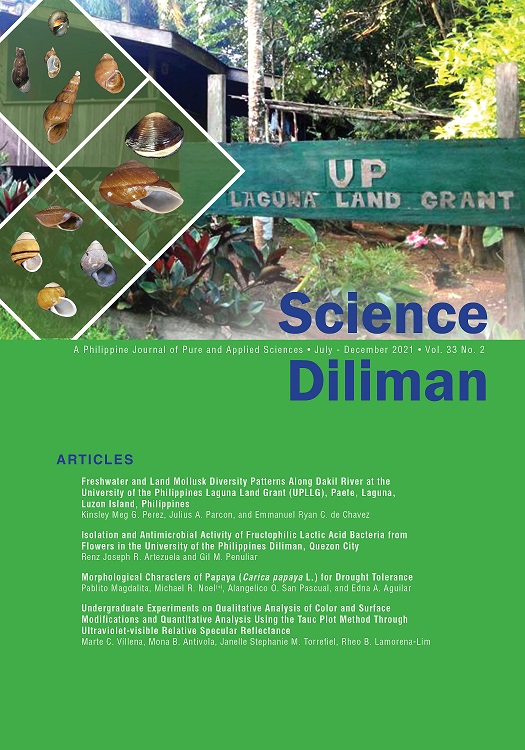Undergraduate Experiments on Qualitative Analysis of Color and Surface Modifications and Quantitative Analysis Using the Tauc Plot Method Through Ultraviolet-Visible Relative Specular Reflectance
Abstract
The study of the spectroscopy of solid materials is not as extensive compared to that of homogeneous liquid solutions. Optical properties, such as reflectance, transmittance, and absorbance, may be used for the characterization of new materials. Qualitative characterization of colored materials and quantitative determination of surface modification and band gap analysis through the Tauc plot method were obtained using visible-reflectance spectroscopy. Differentiation of reflectance peaks was observed in the spectra of colored papers and acrylic spray paints. Expected trends of higher reflectance according to the ability of a color to reflect light were also observed. Surface analysis through the reflectance method indicated that spectra of pristine and surface-modified samples showed a significant difference in signals, which is attributed to the roughening and contamination of the surface of the materials. Using the Tauc plot method on the absorbance spectrum data of an electrodeposited zinc oxide film, the calculated BGE was 3.80 eV, with a 15.15% deviation from its literature value of 3.30 eV. In addition, zinc sulfide, which was chemically deposited on glass slides, had an average band gap of 3.0 eV, with an 8.82% error against its literature value of 3.4 eV. These experiments on specular reflectance of solid materials, particularly optical and new materials, may be incorporated in undergraduate laboratory courses.
Published
2022-04-28
How to Cite
VILLENA, Marte C. et al.
Undergraduate Experiments on Qualitative Analysis of Color and Surface Modifications and Quantitative Analysis Using the Tauc Plot Method Through Ultraviolet-Visible Relative Specular Reflectance.
Science Diliman: A Journal of Pure and Applied Sciences, [S.l.], v. 33, n. 2, apr. 2022.
ISSN 2012-0818.
Available at: <https://journals.upd.edu.ph/index.php/sciencediliman/article/view/8778>. Date accessed: 01 sep. 2025.
Issue
Section
Articles
Submission of a manuscript implies: that the work described has not been published before (except in the form of an abstract or as part of a published lecture, review, or thesis); that it is not under consideration for publication elsewhere; that its publication has been approved by all co-authors, if any, as well as by the responsible authorities at the institute where the work has been carried out; that, if and when the manuscript is accepted for publication, the authors agree to the automatic transfer of the copyright to the publisher; that the manuscript will not be published elsewhere in any language without the consent of the copyright holders; that written permission of the copyright holder is obtained by the authors for material used from other copyrighted sources; and that any costs associated with obtaining this permission are the authors’ responsibility.



